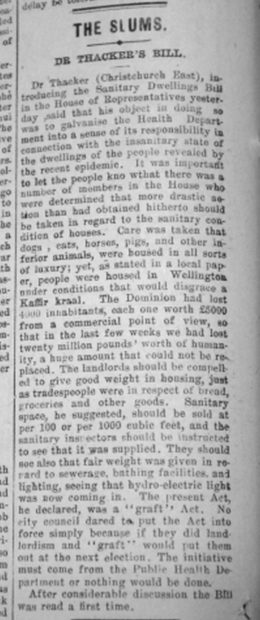
Newspaper clipping – The Slums, 1914 Influenza, Dr Thacker’s Bill.
The cause of the 1918 influenza pandemic was poorly understood. The nature of viruses was undiscovered and scientists and health workers believed the pandemic had been caused by a bacterial infection. The general populace thought the infection was due to, and spread by ‘germs’ and believed that unsanitary conditions in many homes had helped to spread the infection. The matter was raised in Parliament during the height of the pandemic.
Concerns were also being raised at a local authority level.
Some members of the Masterton Borough Council were also determined that the town’s housing stock should be made more hygienic.
A motion was passed stating that the council would ‘go into the matter of better living conditions, making it compulsory for all homes to be equipped with wash-houses, tubs, coppers, bath-rooms, and baths, and that the interior of all houses be kept fit for human habitation.’
Although the resolution was carried by the council, very little seems to have been done to follow up. A ‘Health Vigilance Committee’ was established in Masterton but it met only briefly before folding.
At a national level, a royal commission into the pandemic in 1919 led to a revamping of the health services in New Zealand, with separate divisions dealing with different aspects. The creation of a Division of Maori Hygiene, under the direction of Dr Peter Buck, was instrumental in quickly improving Maori health.
Town planning was also given a boost by the pandemic. Slum removal and urban renewal was a hot topic at the initial meeting of the Federation of Town Planning Associations in 1919.
